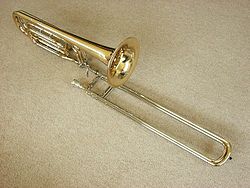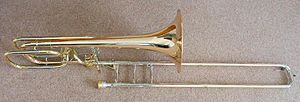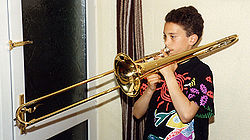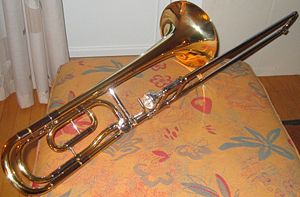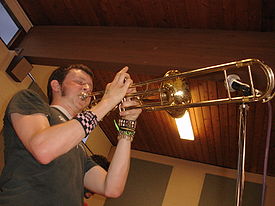- Types of trombone
-
There are many different types of trombone. The most frequently encountered trombones today are the tenor and bass, though as with other Renaissance instruments such as the recorder, the trombone has been built in every size from piccolo to contrabass (pitch of brass instruments). See trombone for information about the instrument in general.
Contents
In order of pitch
Contrabass trombone
The contrabass trombone is usually pitched in 12' F a perfect fourth lower than the modern tenor or bass trombone and has been through a number of changes in its history. Its first incarnation during the Renaissance was in 24' F, one octave below the modern pitch of 12' F, or 18' B♭. During this period it was built as an oversized bass trombone with a long slide and extension handle to reach the lower positions. The innovation of the double slide, in which the slide is wound back on itself to produce four tubes, each of which moves in tandem with its partner and halves the usual length of the slide shifts, took place towards the end of this period and was applied to the bass and contrabass trombones. During the nineteenth century, the contrabass trombone enjoyed a revival and it was constructed according to the double slide principle.
Wagner's Der Ring des Nibelungen (1876) employed the contrabass trombone for the first time in the opera house and was followed by D'Indy's Symphony No. 2 in B♭, Op. 57 in 1902-3, Jour d'été à la montagne, Op. 61 in 1905, Souvenirs, Op. 62 in 1906 and Symphony No. 3 (Sinfonia Brevis - de bello gallico), Op. 70 in 1915, Poème des rivages, Op. 77 in 1919-21, Strauss' Elektra in 1908, and Schoenberg's mammoth cantata Gurre-Lieder (scored for a section of seven trombones including alto and contrabass) in 1913. Verdi's operas Otello (1887) and Falstaff (1893), as well as Puccini's last opera Turandot (1924) also employed the contrabass trombone, albeit that they were scored for the Italian valved contrabass instrument (the "Cimbasso"), and although generally the contrabass trombone has not proven to be a permanent addition to the opera or concert orchestra and is only required in a small number of mainly 20th century works, it has become increasingly used in film scores in recent years.
In 1921 Ernst Dehmel, a German inspector of orchestras and bass trombonist from Berlin, patented a new design of contrabass trombone utilising the old German military band bass trombone in F equipped with two independent rotary valves to replace the handle required on the long slide and to fill in the missing notes between the first partial (fundamental) in closed position and the second partial with the slide fully extended. This bass-contrabass instrument is the precursor of the modern contrabass trombone, which is still largely constructed according to the same principles and to all intents and purposes completely replaced the older double slide variety, which is very rarely seen today. Bore sizes for the slide of the contrabass trombone are typically in the 0.567" to 0.635" range; the most common sizes on contrabass trombones in F are between 0.567" and 0.580" as the larger sizes are usually reserved for the contrabass trombone in low B♭. The bell diameter is typically 10"-11".
Since World War II the contrabass trombone in F with two valve attachments has been primarily in use in orchestras, though the 18' B♭ version is still used by many. Originally due to reasons of limited space conditions in opera orchestra pits, the bell section was provided with a coil to reduce the length of the bell bow, but since the 1970s the long, straight form has taken precedence. Through the combination of both valves the extension handle on the outer slide also became redundant and the instrument is provided with five or six working positions on the slide. Valve tuning combinations are E♭/B♭, D/B♭, or more rarely D/C.
The range of the contrabass trombone (excluding fundamentals or pedal notes) demanded by Wagner is from E1 to E4, though composers since then have required even lower notes - even as low as B♭0. Given that the older B♭ contrabass is less common nowadays in professional ensembles, the F contrabass trombonist produces notes below G♭1 as fundamentals, allowing full access to the range of the older B♭ contrabass trombone and extending the range even lower.
The use of a contrabass trombone almost always requires the addition of a fourth player to the trombone section and while in the past parts for the instrument were sometimes played on a tuba or, more recently, a bass trombone, it is nowadays considered unacceptable to use anything but a contrabass trombone to play these parts, at least in professional settings. Most opera house orchestras and some symphony orchestras require the bass trombonist to double on the contrabass trombone.
Bass trombone
The modern bass trombone is pitched in B♭. It is identical in length to the 9' B♭ tenor trombone and was developed from the 19th century tenorbass trombone, but has a wider bore a and larger bell to aid in the production of a fuller, weightier tone in the low register. It also has one or two valves which, when engaged, lower the key of the instrument to 12' F (and if a second valve is fitted, to G, G♭, E, E♭ or D, depending on the design), allowing the player to bridge the gap between the first partial (fundamental) with the slide in first or closed position and the second partial with the slide fully extended in seventh position. 19th and early 20th century examples of the modern bass trombone were sometimes made with a valve attachment in E rather than F, or with an alternative tuning slide for the attachment tubing enabling the pitch to be lowered to E♭. Bore sizes of the bass trombone are generally slightly larger than those of the largest tenor trombones. Typical specifications include a bore size of 0.562" in the slide and 0.580" through the valve attachment tubing, with a bell from 9" to 10.5" in diameter.
The configuration of the valves falls into one of three categories on the modern bass trombone: a simple B♭/F instrument (of larger dimensions than the B♭/F tenor trombone) equipped with one valve; a B♭/F instrument equipped with a second dependent valve, which relies on the first to be engaged before the ancillary tubing is deployed; a B♭/F instrument equipped with a second independent or in-line valve, which acts independently from the first and may be used to lower the pitch to G or G♭ individually, or to E♭ or D when used in combination with the first valve.
The range of the modern bass trombone is fully chromatic from the lowest fundamental with the valve attachment tubing deployed, potentially as low as C1 or A♭0, up to C5 or higher, depending on the player. It is usually scored in the range B♭1 to B♭4.
There is usually one bass trombone in a standard symphony orchestra (some works call for two) and it is also seen in military bands, brass bands, jazz bands, wind ensembles, and a variety of brass groups; the bass trombone is usually played by the third or fourth trombonist in a trombone section, the first two or three parts usually being for tenor (and possibly alto) trombones.
Bass trombones in G, F, E♭
Older, now obsolete versions of the bass trombone were of smaller bore than the modern bass trombones described above. They were pitched in G, F, E, E♭, D or C and had a longer slide and a handle attached to the outer slide stay to allow for full extension of the slide. These older types of bass trombone were used in Europe and the British Empire.
The oldest of these instruments were the E, D and C bass trombones, which were used in Europe during the Renaissance and early Baroque periods; by the 18th century the F and E♭ bass trombones were used in Germany, Austria and Sweden and the E♭ bass trombone in France, though these fell out of favour in the early nineteenth century and began to be replaced by the tenor trombone, later (after 1840) the tenorbass trombone with F rotary valve attachment.
The bass trombone in G (the orchestral version was in G equipped with a rotary valve attachment actuating D or C, extending the range to A2 or A♭1) enjoyed a period of extended popularity in France during the second half of the nineteenth century, and in Great Britain and the British Empire from approximately 1850 to the 1950s, though it lingered on in some parts of Britain until the 1970s and 1980s and is still occasionally to be seen there in brass bands and period instrument orchestras.
The range of the E♭ bass trombone is A1 to B♭4, that of the F bass trombone is B1 to C5 and that of the G bass trombone is D♭2, or A1 or A♭1 with a D or C valve attachment (the C attachment being used expressly for playing parts written for the contrabass trombone), to D5.
Tenor trombone
The tenor trombone has a fundamental note of B♭ and is usually treated as a non-transposing instrument (see below). Tenor trombones with C as their fundamental note were almost equally popular in the mid-19th century in Britain and France. As the trombone in its simplest form has neither crooks, valves nor keys to lower the pitch by a specific interval, trombonists use seven chromatic slide positions, each of which progressively increases the length of the air column, thus lowering the pitch.
Extending the slide from one position to the next lowers the pitch by one semitone. Thus, each note in the harmonic series can be lowered by an interval of up to a tritone. The lowest note of the standard instrument is therefore an E natural — a tritone below B♭. Most experienced trombonists can play lower "falset" notes and much lower pedal notes (first partials or fundamentals, which have a peculiar metallic rumbling sound). Slide positions are subject to adjustment, compensating for imperfections in the tuning of different harmonics. The fifth partial is rather flat on most trombones and usually requires a minute shortening of the slide position to compensate; other small adjustments are also normally required throughout the range. Trombonists make frequent use of alternate positions to minimize slide movement in rapid passages; for instance, B♭3 may be played in first or fifth position. Alternate positions are also needed to allow a player to produce a glissando to or from a higher note on the same partial.
While the lowest note of the tenor trombone's range (excluding fundamentals or pedal notes) is E2, the trombone's upper range is theoretically open-ended. The practical top of the range is sometimes considered to be F5, or more conservatively D5.
F attachment
 Trombone with F attachment slide position second harmonics.[1]
Trombone with F attachment slide position second harmonics.[1]
Many modern tenor trombones include an extra attachment of tubing - about 3 ft or 1m in length - which lowers the fundamental pitch from B♭ to F. There are two different forms of this tubing, open wrap and traditional, or closed, wrap. The traditional wrap is curved and fits inside the main tuning slide while the open wrap extends past the main tuning slide and only has one curve in it. The F attachment is engaged by using a trigger which operates a valve (this is different from the three-valved valve trombone). This type of trombone is typically built with a larger bore size (0.525" or 0.547") and is known as a B♭/F trombone, F-attachment trombone, or trigger trombone. Trombones without this feature have become known as straight trombones.
The F attachment originated in an instrument developed by German instrument maker Christian Friedrich Sattler during the late 1830s and patented in 1839. It gained popularity at a time when the older German E♭ and F bass trombones had fallen out of favour with orchestral players and were being replaced by a B♭ tenor trombone with a wide bore and large bell proportions. This instrument was known as the tenorbass trombone (German Tenorbaßposaune)—it was a tenor trombone in B♭ with the bore and bell dimensions of a bass trombone, and was used to play both tenor and bass trombone parts.
Sattler used the rotary valve attachment to provide a way to play the notes between the fundamental B♭1 (first position) and the second partial E2 (seventh position). The valve allowed players to produce low E♭, D, D♭, C (and, with adjustments, B), thus making the full range of the old bass trombone in 12' F available and extending the chromatic range of the tenor trombone through the fundamentals to E1.
Sattler's intention was not to create a trombone that would replace the older F and E♭ bass trombones, but rather to provide an instrument with the ability to cover the range of the bass and tenor trombones seamlessly. The tenorbass trombone did replace the older bass trombones, however, and the bore and bell size were increased later in the nineteenth century to allow for models designed specifically to cope with bass trombone parts; modern bass trombones are derivatives of these late nineteenth century B♭/F trombones that are used to play parts originally intended for the bass trombone in G, F or E♭. Since engaging the valve changes the tubing length, additional alternate positions for notes become available. The resulting increase in facility and the addition of the low E♭, D, D♭ and C make these instruments popular among experienced orchestral tenor trombonists.
As the tubing length increases by a factor of one third, the distance between each position must be one third longer when the valve attachment is engaged. This results in only six positions being available, as the slide is too short for what is effectively a bass trombone in 12' F. Because of this, the B two ledger lines below the bass staff is impossible to play unless the attachment is tuned down to E, or the embouchure is loosened. The range of the tenorbass trombone is therefore E1 to B♭1, then C2 to D5.
Alto trombone
The alto trombone is pitched in E♭ (occasionally with a D or B♭ rotary valve attachment) or F, a perfect fourth or fifth higher than the tenor trombone and was commonly used from the 16th to the 18th centuries as the highest voice in the brass choir, though it declined in popularity from the early 19th century, when the trumpet acquired valves and trombones became an established section in the symphony orchestra, and it was replaced by a tenor trombone as the range of the parts can usually be covered by the tenor instrument. While some first trombonists have used the alto trombone as indicated, it was unfashionable from the mid-19th century to the late 20th and has only recently enjoyed something of a revival.
As the slide is shorter, the positions are different from the tenor and bass trombones and as most players are familiar with the slide positions of the B♭ trombone, it is easy to appreciate why the instrument fell out of favour, especially with the increase in upper range and flexibility cultivated by and demanded of first trombonists in the 19th and 20th centuries. The tone of the alto is more brilliant than that of the tenor or bass trombone. The bore of an alto trombone is similar to that of a small tenor trombone - usually around 0.450"-0.500", with a 6.5" or 7" bell.
The range of the E♭ alto trombone (excluding fundamentals or valve attachments) is A2 to B♭5, though it is typically not scored any higher than F5, this being already quite an exalted region for this instrument.
The alto trombone is primarily used in choral, orchestral and operatic settings, although it has enjoyed a history as a solo instrument, primarily in 18th century Vienna. Modern composers have rediscovered the instrument and the alto trombone has begun making more appearances in modern compositions. Nowadays professional orchestral tenor trombonists are expected to play the alto trombone and famous works scored for this instrument include several Mozart masses including the Great Mass in C minor, Requiem, Don Giovanni and Die Zauberflöte, Haydn's Die Schöpfung and Die Jahreszeiten, Beethoven's Symphonies Nos. 5, 6 & 9 and Missa Solemnis, Schubert's Symphonies Nos. 7, 8 & 9, Mass No. 5 in A♭ and Mass No. 6 in E♭, Berlioz' Symphonie Fantastique, Mendelssohn's Symphony No. 2 "Lobgesang", Symphony No. 5 "Die Reformation", Elijah, incidental music to A Midsummer Night's Dream and Ruy Blas, Schumann's Symphonies 1, 2, 3 & 4, Brahms' Symphonies 1, 2, 3 & 4, Akademische Festouvertüre, Tragische Ouvertüre, and Ein deutsches Requiem, as well as a handful of 20th century works including Schoenberg's mammoth cantata Gurrelieder (scored for a section of seven trombones including alto and contrabass) as well as Pelleas und Melisande, Berg's Three Pieces for Orchestra and Britten's The Burning Fiery Furnace.
Soprano trombone
The soprano trombone is usually pitched in B♭ an octave above the tenor and built with a bore size of between 0.450" and 0.470" and a trumpet-sized bell. It appears to have been created in the late 17th century, from which the earliest surviving examples date. It was used in German-speaking countries to play the treble part in chorales, and this tradition survives in Moravian trombone choirs. During the 20th century some soprano trombones—dubbed slide cornets— were made as novelties or for use by jazz cornet players, but the instrument has never been widely used. It is easily replaced by the cornet or woodwind instruments and it is difficult to play in tune. Soprano trombone slides are short and often have only six positions rather than seven. The soprano trombone is usually played by a trumpeter owing to the high pitch of the instrument and similar embouchure.
The range of the B♭ soprano trombone is E3 to C6, though it is not usually written higher than B♭5.
Sopranino and piccolo trombones
The sopranino and piccolo trombones are even smaller and higher instruments than the soprano; they are also extremely rare. Sopranino and piccolo are pitched in high E♭ and B♭ respectively, one octave above the alto and soprano trombones. They are called for in some trombone choir literature, the sopranino, for example, being used in the Moravian trombone choirs in the USA. Bore sizes vary between 0.430" and 0.400" respectively, with bells approximately 4" in diameter. Owing to the very high pitch of these instruments and their use of trumpet mouthpieces, they are played primarily by trumpeters.
The range of the E♭ sopranino trombone is A3 to E♭6; that of the B♭ piccolo trombone is E4 to F7.
Valve trombone
The valve trombone has been built in every size from alto to contrabass, though it is the tenor valve trombone which has seen the most widespread use. They are built in either short or long form.
The valve trombone enjoyed its greatest popularity in the 19th century when the technology of rotary valve and piston valve instruments was developing rapidly. By the end of the 19th century, mass production of reliable, higher quality slide trombones led to a return of its popularity. Despite the continuing popularity of the slide trombone, valve trombones have remained popular in, for example, Austria, Italy, Bohemia, Moravia, Slovakia, Spain, Portugal, South America and India, almost to the exclusion of the slide trombone.
A bass or contrabass version of the valve trombone is the cimbasso and is used mainly in operatic works by Giuseppe Verdi and Giacomo Puccini.
Some passages, particularly fast musical figures, are easier to execute on a valve trombone than on a slide trombone. Many players consider the tone of a valve trombone to be stuffier and less open, and it is not common in orchestral settings, though Giuseppe Verdi in particular made extensive use of the ability of the valve trombone to negotiate its way through fast passages in his works. As the B♭ tenor valve trombone uses the same fingering as the B♭ trumpet, it is occasionally a doubling instrument for jazz trumpeters. Notable jazz musicians who play the B♭ tenor valve trombone include Maynard Ferguson, Bob Brookmeyer, Juan Tizol of the Duke Ellington Orchestra, Rob McConnell and Bob Enevoldsen.
A valve trombone made by Adolphe Sax has a different system from that which is normally used. Instead of three valves in the style of the trumpet, it has one for each position on the trombone slide.
Superbone
Main article: SuperboneThis unusual variation of the trombone has both a slide and valves. Different types of valve-slide trombone hybrid combinations were first manufactured in the early 20th century. One of the best known early types was the valide trombone invented by jazz trombonist and reedist Brad Gowans, which featured a slide on the inside on the valves which did not lock, forcing the player to actively use both hands. The most popular valve-slide trombone combination today is the superbone, which achieved fame and popularity thanks to the influence of jazz musician Maynard Ferguson, who used it in his band. The Superbone has a slide on the outside of the valves which locks, meaning its use is optional, and the player can play the Superbone valves with either hand.
Tromboon
Main article: TromboonThe tromboon was created by musical parodist Peter Schickele by replacing a trombone's leadpipe with the reed and bocal of a bassoon. The name of the instrument is a portmanteau word of "trombone" and "bassoon". Schickele called it "a hybrid—that's the nicer word—constructed from the parts of a bassoon and a trombone; it has all the disadvantages of both." It is called for in the scores of Schickele's fictional composer P. D. Q. Bach in the oratorio The Seasonings, in Serenude (for devious instruments), and in The Preachers of Crimetheus, II. The Lamentations of Jerry Maja.
Buccin
Main article: BuccinA distinctive form of tenor trombone was popularized in France in the early 19th century. Called the buccin, it featured a tenor trombone slide and a bell that ended in a zoomorphic (serpent or dragon) head. Hector Berlioz wrote for the buccin in his Messe solennelle of 1824.
References
- ^ Kennan and Grantham (2002). The Technique of Orchestration, p.148-149. ISBN 0-13-040771-2.
- Herbert, Trevor (2006). The Trombone London: Yale University Press. ISBN 0-300-10095-7 .
- ed. Sadie, Stanley and Tyrrell, John (2001). The New Grove Dictionary of Music and Musicians. London: Macmillan. ISBN 0-19-517067-9 .
- Adey, Christopher (1998). Orchestral Performance. London: Faber & Faber. ISBN 0-571-17724-7 .
- ed. Herbert, Trevor & Wallace, John (1997). The Cambridge Companion to Brass Instruments. Cambridge: Cambridge University Press. ISBN 0-521-56522-7 .
- Blatter, Alfred (1997). Instrumentation and Orchestration. Belmont: Schirmer. ISBN 0-534-25187-0 .
- Wick, Denis (1984). Trombone Technique. Oxford: Oxford University Press. ISBN 0-19-322378-3 .
- Del Mar, Norman (1983). Anatomy of the Orchestra. London: Faber & Faber. ISBN 0-520-05062-2 .
- Montagu, Jeremy (1981). The World of Romantic & Modern Musical Instruments. London: David & Charles. ISBN 0-7153-7994-1 .
- Baines, Anthony (1980). Brass Instruments: Their History and Development. London: Faber & Faber. ISBN 0-571-11571-3 .
- Montagu, Jeremy (1979). The World of Baroque & Classical Musical Instruments. New York: The Overlook Press. ISBN 0-87951-089-7 .
- Bate, Philip (1978). The Trumpet and Trombone. London: Ernest Benn. ISBN 0-510-36413-6 .
- Montagu, Jeremy (1976). The World of Medieval & Renaissance Musical Instruments. New York: The Overlook Press. ISBN 0-87951-045-5 .
- Gregory, Robin (1973). The Trombone: The Instrument and its Music. London: Faber & Faber. ISBN 0-571-08816-3 .
- Maxted, George (1970). Talking about the Trombone. London: John Baker. ISBN 0-212-98360-1 .
- ed. Bluhme, Friedrich (1962). Die Musik in Geschichte und Gegenwart. Kassel: Bärenreiter.
- Kunitz, Hans (1959). Die Instrumentation: Teil 8 Posaune. Leipzig: Breitkopf & Härtel. ISBN 3-7330-0009-9 .
- ed. Lavignac, Albert (1927). Encyclopédie de la musique et Dictionnaire du Conservatoire. Paris: Delagrave.
External links
Categories:- Brass instruments
- Continuous pitch instruments
- Bass (sound)
Wikimedia Foundation. 2010.

